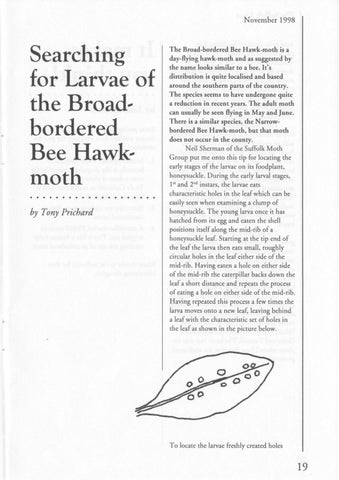The Suffolk Argus
November 1998
The group is chaired by one of the members of the group and is reviewed every three years. The group is administered by the Suffolk Coastal District Council, again subject to a three yearly review. Representatives from other organisations are co-opted at various times ro facilitate an improved understanding and co-ordination of management initiatives. We in Suffolk Butterfly Conservation were involved last year in checking various sites for bell heather to assess their suitability for Silver-studded Blues. This has already resulted in the release of Silver-studded blues at a new site, as featured in the local press and on television The Sandlings Group is an excellent example of many organisations working together for the good of an area of Outstanding Natural Beauty. Thanks go to the Sandlings group for giving us permission to extract much of the above from their terms of reference.
c0J
In response to Wilfred George's article (last newsletter) by Steve Goddard I was very interested to read about Large White larvae still feeding as late as December of 1997 (Large and Late by Wilfrid George, volume 14). Like Wilfrid, I also wondered whether this was a record. However, I was astounded to find that on reference to The Butterflies of Great Britain and Ireland, volume 7, part I, Emmet & Heath (Eds), Harley Books, it transpires that larvae occur 'ftom early May to early December and very occasionally into January ... '. Sorry Wilfrid, it seems that you needed to leave your cabbages to the ravages of these caterpillars for at least another month to claim any record!
Searching for Larvae of the Broadbordered Bee Hawktnoth by TonyPrichard
The Broad-bordered Bee Hawk-moth is a day-flying hawk-moth and as suggested by the name looks similar to a bee. It's distribution is quite localised and based around the southern parts of the country. The species seems to have undergone quite a reduction in recent years. The adult moth can usually be seen flying in May and June. There is a similar species, the Narrowbordered Bee Hawk-moth, but that moth does not occur in the county. Neil Sherman of the Suffolk Moth Group put me onto this tip for locating the early stages of the larvae on its foodplant, honeysuckle. During the early larval stages, 1" and 2"d instars, the larvae eats characteristic holes in the leaf which can be easily seen when examining a clump of honeysuckle. The young larva once it has hatched from its egg and eaten the shell positions itself along the mid-rib of a honeysuckle leaf. Starting at the tip end of the leaf the larva then eats small, roughly circular holes in the leaf either side of the mid-rib. Having eaten a hole on either side of the mid-rib the caterpillar backs down the leaf a short distance and repeats the process -of eating a hole on either side of the mid-rib. Having repeated this process a few times the larva moves onto a new leaf, leaving behind a leaf with the characteristic set of holes in the leaf as shown in the picture below.
\\ '"~ '\
Silver-studdedBlue by BerylJohnson To locate the larvae freshly created holes
6
19
